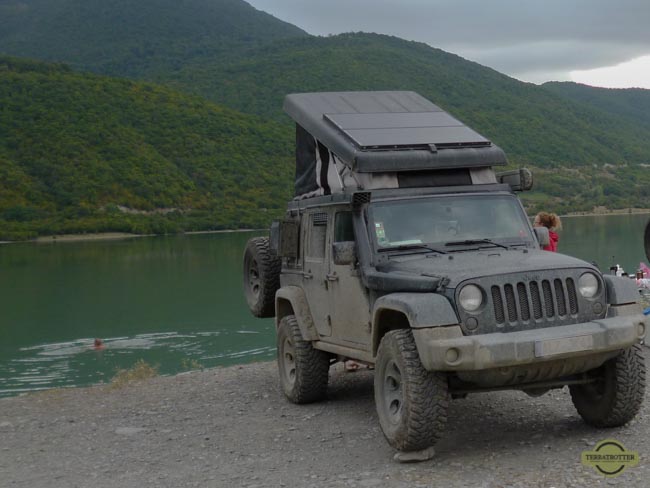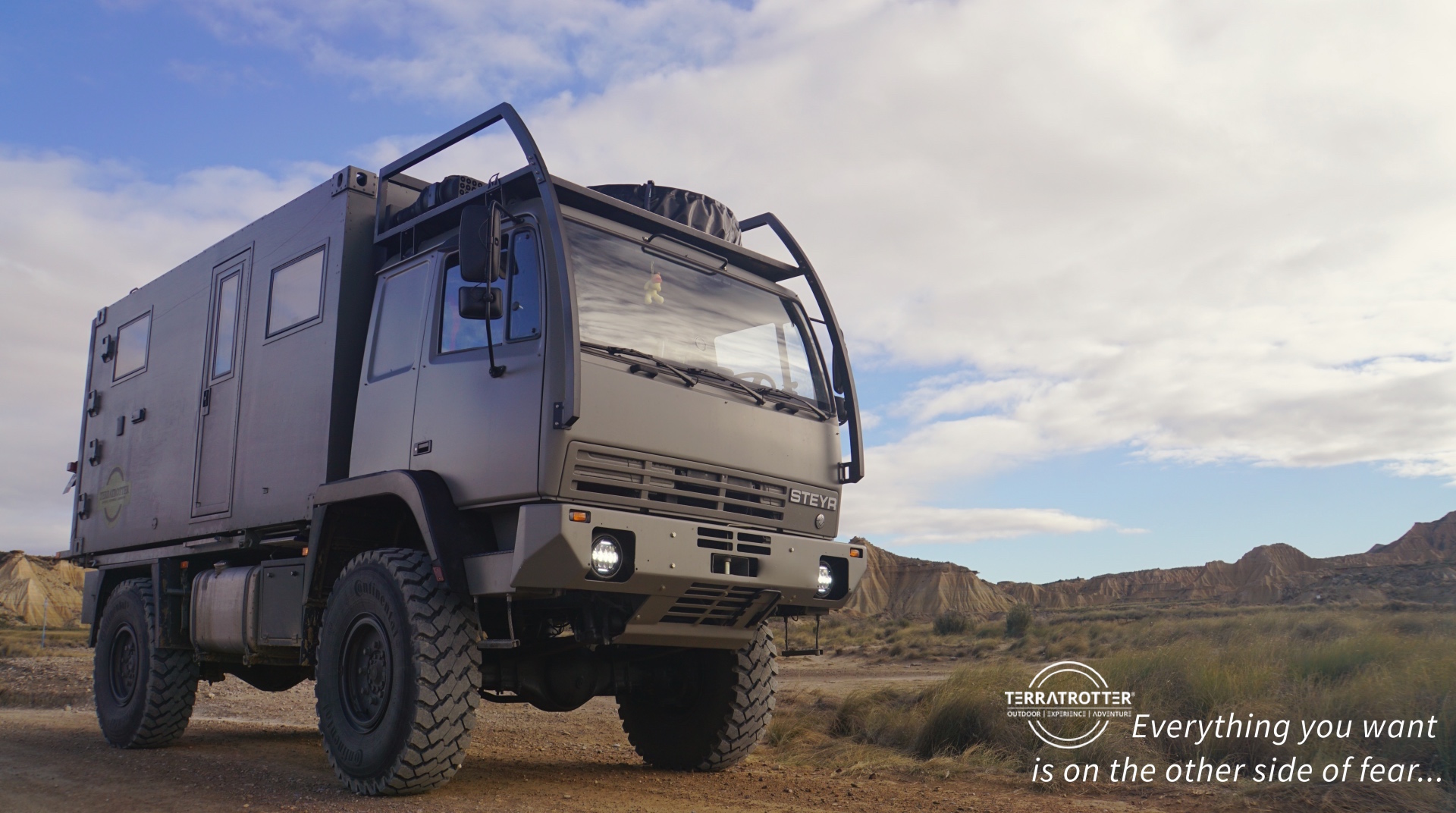When planning an overland journey the question quickly arise: should I install solar panels and how much? This article addresses the very basics of a solar system on expedition vehicles: why, voltage-amperage-wattage, how to calculate your consumption, battery capacity, recharging batteries by solar power.
We are no experts in solar systems, far from it. Honestly, we had to learn most of it from Dr. Google. To assure our system was in balance and up to the task we asked an professional to help us put our package together. But this guy is not coming with us on the road (nor is he installing it) thus a basic understanding of the magic called solar power is vital. Since it took us far too long to find information about the very basic stuff, we decided to write it down for you. Hopefully this will give you a head start and save you precious time.
Why install Solar Panels on your Overland Vehicle?
Before we start with the technical bits, why is solar becoming so popular within the overland community? Solar basically plays a big role in the freedom that can be experienced during overland traveling. You can go off-grid; meaning you no longer have to frantically look for RV parks or camping grounds when you want to stay put for a few days. Solar panels give you the independence to go wild camping for a while (often also called boondocking). In addition, solar provides the means for sustainable traveling. You no longer have to wake up the entire neighborhood or pollute Mother Nature while juicing your batteries (in contrast to most generators). You can peaceful enjoy that hidden paradise you discovered.
Here are then the answers to your technical questions:
1. WHAT ABOUT
o VOLTAGE (VOLTS, V)?
= the FORCE (pressure) of electricity
o AMPERAGE (AMPS, A)?
= the AMOUNT of electricity that is used or flows (electrical current).
1 AC Amp is not equal to 1 DC Amp!
o WATTAGE (WATTS, W)?
= the electrical POWER (work or effort) appliances need. Also the power generated by solar panels is expressed in watt.
Watt = Amp x Volt
2. HOW TO CALCULATE YOUR CONSUMPTION?
Electricity consumption is often expressed in amp-hour (Ah)
Example 1 – Shower:
Use of the shower for 10minutes with a 24V* water pump (2.2 A)
(*We built a 24V system in our truck)
10min/60 = 0.17 hour
0.17 x 2.2 DC Amp = 0.37Ah of consumption in one day
Example 2 – Laptop:
Charging the laptop with a 45W charger for 4 hours:
45W/24V = 1.88A
1.88A x 4hrs = 7.52Ah of consumption daily
(note: the power drainage of the inverter, to charge your computer on AC power, should be taken into account as well)
Example 3 – Fridge:
According to the specs our compressor fridge consumes on average (a compressor fridge does not run all the time) 2.2Ah each hour on a 12 volt-system with outside temperatures of 25°C (+5°C indoors).
2.2Ah/h : 2 = 1.1Ah/h on a 24V system
1.1Ah x 24hrs in a day = 26.4Ah of consumption in one day (This increases rapidly with increasing ambient temperature)
When you calculate this for all your other appliances and sum it all up you receive a rough estimation of what your electricity consumption is in one day.
3. BATTERY CAPACITY
o SERIES vs PARALLEL
Inside the truck’s living unit we installed 2 x 12V batteries (220Ah each) in series, to create our 24V system with a 220Ah capacity. When you wire them in parallel the Voltage stays the same (12V), but the Amperage doubles (440Ah).
o DEPTH OF DISCHARGE
Deep Cycle AGM batteries should never discharge more than 50%. When you manage to only discharge them for 30% their cycle life almost triples (1500 instead of 600); this means, in our example, we could only draw 66Ah from the batteries (if they are not recharged in the meantime).
o TEMPERATURE
Temperature has also a large effect on your batteries. Temperatures largely exceeding 20°C (68°F) decrease the service life of batteries. Temperatures far below 20°C (68°F) decrease the capacity of the batteries.
Tip: Install a battery bank that is approx. 4 times bigger than your daily consumption. (from rv-travel-lifestyle.com)

4. RECHARGING BATTERIES BY SOLAR POWER
When researching solar panels don’t forget to look at the Voc (Voltage-open-circuit; no load), the Vmpp (Voltage-max–power-point; peak voltage) and Impp (maximum power point current; peak amperage) that is mentioned on the spec sheet. We for example chose for four 190W-24V Monocrystal solar panels of which the spec of each panel mentioned Voc: 43.2V, Vmpp: 36V, Impp: 5.44A.
o HOW MUCH?
Assume our daily total consumption is 60Ah.
Not all the power generated by the solar panels is stored in the batteries. There is some loss. Therefore, solar panels have to produce more electricity than what is consumed in one day to recharge the batteries completely. Also during the winter months the solar panels are less efficient (suboptimal angle of the sun & less sun).
As rule of thumb increase your daily Ah need by 1.2 (from rv-travel-lifestyle.com). Thus, in our example the solar panels have to generate 72Ah (60Ah x 1.2) each day to recharge the batteries.
Another guiding rule we found was that for each 2Ah of battery capacity you should count a minimum of 1.5W solar power. Our example: 110 (220Ah battery capacity:2) x 1.5 = 165W.
o HOW QUICKLY?
When we know what the solar system has to produce in one day the question now becomes, how quickly they have to be able to do that.
In the depth of winter only 5 hours of daylight is not an exception in some northern regions like the Scandinavian countries. Thus, our solar system has to generate around 14.4A each hour (72 : 5) to completely recharge our batteries those short winter days. If our panels would fail to do so, we will eventually have to go for a long ride (since we can also charge our batteries that way) or find shore power.
Please, let us know if this basic overview helped you on your way.


Importantly it is also critical to look at the solar charge controller as different controllers will affect charge rates and determine how expandable the system may be in the future. I use an MPPT controller with good results.
Nice article, solar is great for tourers, here in Australia we get plenty of sun so it works well but our fridges also have to work harder due to the heat.
Thank you Andrew for the compliment and you are indeed right, a good solar charge controller (MPPT) is indeed very important as well. We plan to write more about this and other related appliances/instruments in the near future.
As promised, a post about MPTT controllers and more: http://www.terratrotter.eu/electrical-system-expedition-vehicle/
I forgot to add last time that we might add a few extra fans around the fridge to keep air around it as cool as possible. But of course in Australian heat there is only that much you can do.
Good info. I suck at understanding electronics so I’ve been looking for info on adding solar panels to my Ford Expedition. Thanks!
We totally understand. We spend hours on the web, trying to figure it out. We’re happy we were able to help you this way.
Good luck and happy travels!
Nicole & Elmer
Very useful and interesting explanation of how to size your solar. Thanks.
Thank you Clive for your positive feedback. We really appreciate it!